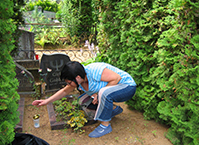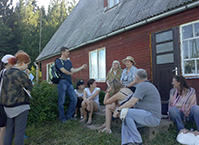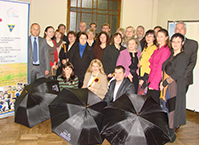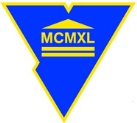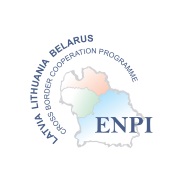Prewar clothing
Categories: Family, Eugenia Begetskaya
What kind of clothes did people wear before the war?
Oh my God, what kind of clothes?! What kind of special clothes, guys? We had everything hand made. Some clothes were weaved, we could sew a skirt from the fabric, a blouse from the fabric, or knit a blouse and put it on, and we knitted dresses from thin flax thread! You see what kind of clothes we had. Everything was weaved and knitted and that’s all.
And what colour were the clothes?
Everyone could choose what he wanted… There were lots of dyes at the shops. People used the dyes what they wanted. Oh, I had to get the boys dressed, I used different ones, because mother-in-law, I told you, couldn’t do this, so I had to do everything by myself, so I dyed the cloth into the colour I wished. Boys want everything dyed into dark colours. You know. And costumes were weaved. Costumes were weaved from the sheep woolen cloth. And we made woolen costumes for men. We had no money to buy them, so all of them were weaved.
Did you spin by yourselves?
Yes, indeed?! I didn’t have mother. My mother’s-in-law sisters taught me how to do this. They were good needlewomen. They were five in the family. And she (mother-in-law) was the sixth. She could neither spin nor weave. She was doing more with men’s household duties. They taught me to weave, to spin, to sew, to embroider, to cook, to bake and everything – everything in the world – they taught me to do everything. However, there’s nobody still alive from their family. All folks have already passed away. It used to be a big open-air party organized by their children, the elders generation didn’t come. If there is a wedding, or army send-off party – they always invited us.
How did you make woolen cloth?
We trimmed, and then teased. We teased them on such a special ripple, teased. We span, then weaved from the thread. Somebody weaved, somebody knitted or did anything else. I can knit kerchiefs, triangular headscarf, jackets, everything.
When wheat was gathered, flax became ripe. It blooms, and then seed heads appear. If heads are yellow, it means it’s time to gather them. They gathered them. They gathered, then shook the seeds out. They dried them, then shook them out. We had so called ‘pryaniki’ (a tool for shaking out the seeds). They shook them out and if there were lots of seeds, they were cleaned out. After that we spread the flax. We left it to dry, and the fiber got peeled off. And then we scraped the fiber against the ‘tsernitsa’ (a tool for scraping flax), cleared out, scratched by iron and other brushes, and then span and were ready to weave.
Images
Audio
Researcher: Наталья Иващенко, кандидат исторических наук, ГрГУ им. Я. Купалы, Ксения Адасик, ГрГУ им. Я. Купалы


